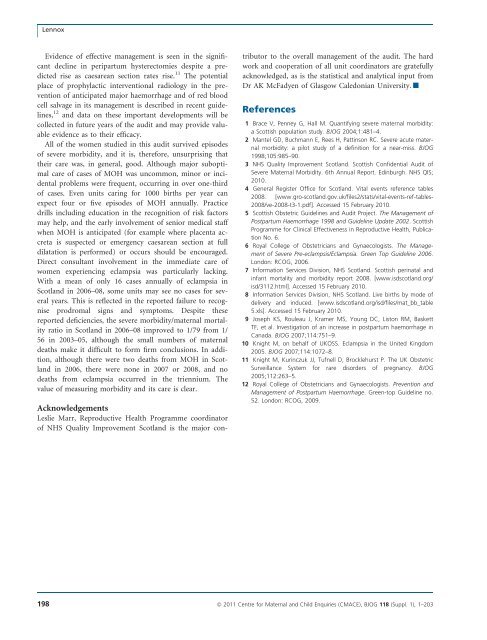6.-March-2011-Saving-Mothers-Lives-reviewing-maternal-deaths-to-make-motherhood-safer-2006-2008
6.-March-2011-Saving-Mothers-Lives-reviewing-maternal-deaths-to-make-motherhood-safer-2006-2008
6.-March-2011-Saving-Mothers-Lives-reviewing-maternal-deaths-to-make-motherhood-safer-2006-2008
Create successful ePaper yourself
Turn your PDF publications into a flip-book with our unique Google optimized e-Paper software.
LennoxEvidence of effective management is seen in the significantdecline in peripartum hysterec<strong>to</strong>mies despite a predictedrise as caesarean section rates rise. 11 The potentialplace of prophylactic interventional radiology in the preventionof anticipated major haemorrhage and of red bloodcell salvage in its management is described in recent guidelines,12 and data on these important developments will becollected in future years of the audit and may provide valuableevidence as <strong>to</strong> their efficacy.All of the women studied in this audit survived episodesof severe morbidity, and it is, therefore, unsurprising thattheir care was, in general, good. Although major suboptimalcare of cases of MOH was uncommon, minor or incidentalproblems were frequent, occurring in over one-thirdof cases. Even units caring for 1000 births per year canexpect four or five episodes of MOH annually. Practicedrills including education in the recognition of risk fac<strong>to</strong>rsmay help, and the early involvement of senior medical staffwhen MOH is anticipated (for example where placenta accretais suspected or emergency caesarean section at fulldilatation is performed) or occurs should be encouraged.Direct consultant involvement in the immediate care ofwomen experiencing eclampsia was particularly lacking.With a mean of only 16 cases annually of eclampsia inScotland in <strong>2006</strong>–08, some units may see no cases for severalyears. This is reflected in the reported failure <strong>to</strong> recogniseprodromal signs and symp<strong>to</strong>ms. Despite thesereported deficiencies, the severe morbidity/<strong>maternal</strong> mortalityratio in Scotland in <strong>2006</strong>–08 improved <strong>to</strong> 1/79 from 1/56 in 2003–05, although the small numbers of <strong>maternal</strong><strong>deaths</strong> <strong>make</strong> it difficult <strong>to</strong> form firm conclusions. In addition,although there were two <strong>deaths</strong> from MOH in Scotlandin <strong>2006</strong>, there were none in 2007 or <strong>2008</strong>, and no<strong>deaths</strong> from eclampsia occurred in the triennium. Thevalue of measuring morbidity and its care is clear.AcknowledgementsLeslie Marr, Reproductive Health Programme coordina<strong>to</strong>rof NHS Quality Improvement Scotland is the major contribu<strong>to</strong>r<strong>to</strong> the overall management of the audit. The hardwork and cooperation of all unit coordina<strong>to</strong>rs are gratefullyacknowledged, as is the statistical and analytical input fromDr AK McFadyen of Glasgow Caledonian University. jReferences1 Brace V, Penney G, Hall M. Quantifying severe <strong>maternal</strong> morbidity:a Scottish population study. BJOG 2004;1:481–4.2 Mantel GD, Buchmann E, Rees H, Pattinson RC. Severe acute <strong>maternal</strong>morbidity: a pilot study of a definition for a near-miss. BJOG1998;105:985–90.3 NHS Quality Improvement Scotland. Scottish Confidential Audit ofSevere Maternal Morbidity. 6th Annual Report. Edinburgh. NHS QIS;2010.4 General Register Office for Scotland. Vital events reference tables<strong>2008</strong>. [www.gro-scotland.gov.uk/files2/stats/vital-events-ref-tables-<strong>2008</strong>/ve-<strong>2008</strong>-t3-1.pdf]. Accessed 15 February 2010.5 Scottish Obstetric Guidelines and Audit Project. The Management ofPostpartum Haemorrhage 1998 and Guideline Update 2002. ScottishProgramme for Clinical Effectiveness in Reproductive Health, PublicationNo. <strong>6.</strong>6 Royal College of Obstetricians and Gynaecologists. The Managemen<strong>to</strong>f Severe Pre-eclampsis/Eclampsia. Green Top Guideline 200<strong>6.</strong>London: RCOG, 200<strong>6.</strong>7 Information Services Division, NHS Scotland. Scottish perinatal andinfant mortality and morbidity report <strong>2008</strong>. [www.isdscotland.org/isd/3112.html]. Accessed 15 February 2010.8 Information Services Division, NHS Scotland. Live births by mode ofdelivery and induced. [www.isdscotland.org/isd/files/mat_bb_table5.xls]. Accessed 15 February 2010.9 Joseph KS, Rouleau J, Kramer MS, Young DC, Lis<strong>to</strong>n RM, BaskettTF, et al. Investigation of an increase in postpartum haemorrhage inCanada. BJOG 2007;114:751–9.10 Knight M, on behalf of UKOSS. Eclampsia in the United Kingdom2005. BJOG 2007;114:1072–8.11 Knight M, Kurinczuk JJ, Tufnell D, Brocklehurst P. The UK ObstetricSurveillance System for rare disorders of pregnancy. BJOG2005;112:263–5.12 Royal College of Obstetricians and Gynaecologists. Prevention andManagement of Postpartum Haemorrhage. Green-<strong>to</strong>p Guideline no.52. London: RCOG, 2009.198 ª <strong>2011</strong> Centre for Maternal and Child Enquiries (CMACE), BJOG 118 (Suppl. 1), 1–203


